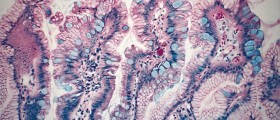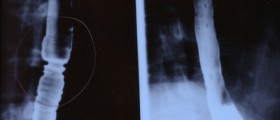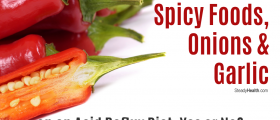Pain in the esophagus can be caused by a number of health conditions.
Esophagus is a tube that connects the pharynx (throat) with the stomach and it is around 10 inches long. Esophagus carries food, saliva, and liquids from the mouth to the stomach. Pain in the esophagus can indicate several diseases but it may be hard to diagnose since esophagus pain can be similar to chest pain due to heart problems.

Causes of Esophagus Pain
Acid Reflux Disease
Esophagus pain most commonly results from acid reflux disease. This condition occurs when gastric juices containing acid travel back from the stomach to the esophagus.
Acid reflux disease causes esophagus pain, heartburn, regurgitation of food, and difficulty swallowing. Long-term acid reflux disease can result in Barrett’s esophagus.
Esophagitis
Esophagitis refers to inflammation of the lining of the esophagus. This condition can be caused by acid reflux disease, vomiting, medications, weak immune system, esophageal infection, alcohol use, and other reasons.
Esophagitis is followed by pain, heartburn, difficulty swallowing, hoarseness, and sore throat.
Esophageal Spasm
Esophageal spasm is characterized by painful muscle contractions in the esophagus. The condition can cause sudden sharp pain in the esophagus. Esophageal spasms can also lead to difficulty swallowing, burning pain in the chest, and regurgitation.
Sphincter Irregularities
Sphincter is a ring-like muscle that controls the entry or exit of contents from a passage. The gastroesophageal sphincter represents the valve at the top of the stomach that allows the food to pass from the esophagus to the stomach.
It is also known as the cardiac sphincter. If spasms occur in the gastroesophageal sphincter it can lead to abnormal propulsion of food or regurgitation of food from the stomach and it will result in pain in the esophagus.
Cancer of the Esophagus
Cancer that occurs in the esophagus can be caused by recurring acid reflux disease attacks, smoking, alcohol drinking, and too much spicy food in a diet.
Esophageal cancer typically causes pain in the esophagus, difficulty swallowing, and unusual weight loss.
Other Causes of Esophagus Pain
Apart from mentioned causes, pain in the esophagus may occur due to trauma to the esophagus, either physical or chemical.
- The principal temperature receptors in the oesophagus are members of the transient receptor potential family. Several temperature receptors exist, among others the transient receptor potential vanilloid 1 (TRPV1), whose threshold for activation can be lowered by hydrogen ions and inflammatory mediators.
- The afferent fibres of the first order neuron are either nonmyelinated (70–90%) or thinly myelinated fibres. In organs such as the pancreas and ureter the afferents convey only pain, whereas in others (oesophagus, stomach and rectum) the afferents mediate pain together with other sensations.
- The oesophagus is dually innervated by vagal and spinal nerves. Most afferent fibres run temporarily together with either the sympathetic or parasympathetic nerves to enter the spinal cord. Afferents mediating sensory information travel mainly together with the sympathetic nerves, whereas those traveling together with the parasympathetic nerves are mainly involved in secretion, motor, and regulatory reflexes that do not reach consciousness. In the oesophagus, however, nerves traveling together with the vagal nerves also transmit pain, and there is increasing evidence for pain transmission via vagal afferents from other segments of the gut.
- The clinical picture of oesophageal disorders depends on the pathophysiology responsible for their development. In some diseases, for example ERD, excess oesophageal acid exposure is thought to be the main pathophysiological factor underlying their development.
- Barrett's oesophagus (BO) is a metaplastic condition in the oesophagus, in which the squamous epithelium is replaced with columnar epithelium, so far considered to arise due to excess gastro-oesophageal reflux. The prevalence is rising and probably around 1.6% in the general population of Western countries.
- A meta-analysis by Khan et al. including 35.978 patients with erosive oesophagitis found proton pump inhibitor (PPI) to be roughly 4 times as effective as placebo and twice as effective as histamine 2 receptor antagonists in healing erosive oesophagitis. Also, they showed a modest, but significant effect on the healing of oesophagitis when doubling the PPI dose, with a number needed to treat of 25.
- Surgical treatment of reflux is more effective than medical treatment of reflux and pain. The primary surgical method is Nissen fundoplication, in which the gastric fundus is wrapped around the oesophagus to create an artificial valve to support the insufficient upper oesophageal sphincter. A meta-analysis including 1232 patients showed improvement in quality of life, GORD-related symptoms, and 24-hour pH up to 1 year after an operation with Nissen fundoplication compared to medical treatment with PPIs.
Esophagus pain can also result from perforation of the esophagus, injuries to the esophagus due to radiation, esophageal burns caused by excessive intake of spicy and highly acidic foods, and other factors.
Treatment of Esophagus Pain
The treatment depends on the underlying cause of the pain in the esophagus. Thereby, a precise diagnosis should be made.
Acid reflux disease can be treated with a GERD diet that includes bland and non-spicy food. Esophageal spasms are treated with anti-spasmodic medications. Esophageal cancer is treated with chemotherapy, radiation therapy, and surgery.

















Your thoughts on this
Loading...